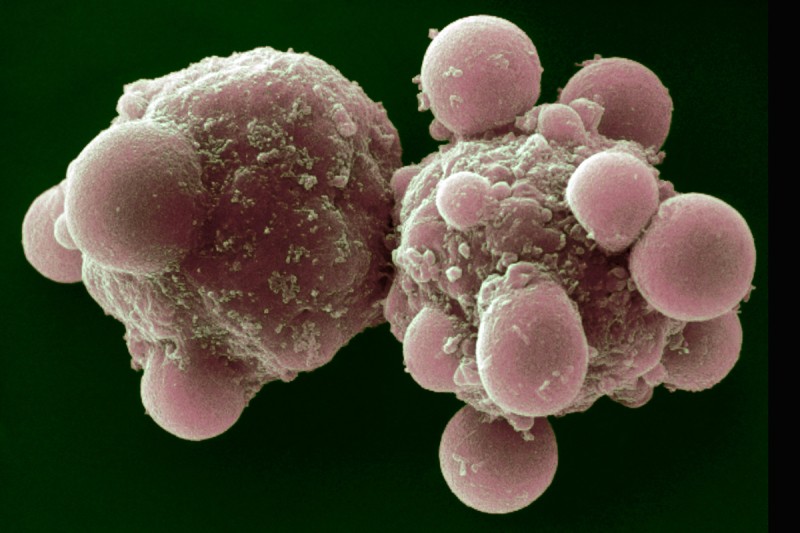
Liver cells blebbing and undergoing apoptosis
The death of one tiny cell might seem like a simple thing. But the process is much more complicated than you would expect.
There are actually several types of cell death, each with its own unique characteristics and processes. One of the most well-studied is called apoptosis.
“Apoptosis is defined by a set of physical, often visible, features that are associated with the demise of an individual cell,” says Memorial Sloan Kettering cell biologist Michael Overholtzer. “It’s probably one of the most common forms of cell death during the development of an organism. It also plays an important role in cancer.”
One purpose of apoptosis is to eliminate cells that contain potentially dangerous mutations. If a cell’s apoptosis function is not working properly, the cell can grow and divide uncontrollably and ultimately create a tumor.
Visible Changes, Molecular Changes
So what do you see if you look at an apoptotic cell under a microscope? “The nucleus looks shrunken or condensed and fragmented into pieces, whereas a normal nucleus is one round oval,” Dr. Overholtzer explains.
“The other obvious feature is that the cells themselves would shrink and begin to bleb,” he adds. “Blebbing means that the cell’s membrane changes, and there are bulging protrusions from the surface of the cell.”
An enzyme called caspase starts the chain reaction of changes that lead to a cell’s death by apoptosis. “Caspase is essentially like molecular scissors,” Dr. Overholtzer says. “In a normal, happy cell, it’s inactive, but once a cell is either put under stress or developmentally programmed to commit suicide, the scissors are activated and start to cut up certain proteins inside the cell, beginning the apoptosis process.”
In cancer cells, however, the scissors may not get the signal to start cutting. “The sensor that recognizes cell damage may not work, and the signal is never sent,” he says. “There are currently strategies under way to develop drugs that would help reactivate the sensor and therefore activate apoptosis.”
One of those sensors is a well-studied protein called p53. When it functions normally, it suppresses the formation of cancer through apoptosis. Mutations in the p53 gene are found in about half of all cancers.
Other Forms of Cell Death
Another common form of cell death is necrosis, which occurs when a cell is injured or ruptured. “Historically we thought that necrosis just happened in response to an injury, for example a burn or a cut,” Dr. Overholtzer says. “In the past five years, however, studies have shown that necrosis is also programmed, but in a completely different way than apoptosis.”
A third well-studied type is called autophagy, in which a cell breaks down and digests itself. Autophagy can occur as a natural part of growth and development, but it can also be a response to certain diseases or stress, such as infection. Similar to apoptosis, autophagy can play a role in cancer, if it doesn’t occur when it should and cells are able to grow out of control.
Dr. Overholtzer’s lab is studying yet another kind of cell death, called entosis, in which one cell engulfs another and kills it. “Entosis is a completely different process,” he says. “The other types of cell death are all forms of suicide, but this is really a murdering event.”
He first discovered entosis as a postdoctoral fellow while studying breast cancer cells under a microscope, when he observed some of the cancer cells entombing neighboring cells. Some of the captured cells escaped unharmed, and some were able to continue dividing inside the host cell, but most eventually died.
Other cases of cells murdering cells that have been observed are different because they result from two different cell types, which are in many cases also distinct genetically, competing against each other. “In this case, cells are killing cells that are identical to themselves,” Dr. Overholtzer says. “We’ve even seen cases where a cell has divided and one daughter cell kills the other one.”
Investigators don’t know yet whether entosis occurs in healthy, normal cells, but it’s something that Dr. Overholtzer and his team are continuing to study.
“Any time you have a new window into how cell death works, particularly a program that you can see going on in a tumor, that’s a real opportunity to dive in and see if you can learn how to manipulate it with the goal of finding new cancer treatment strategies,” he concludes.


